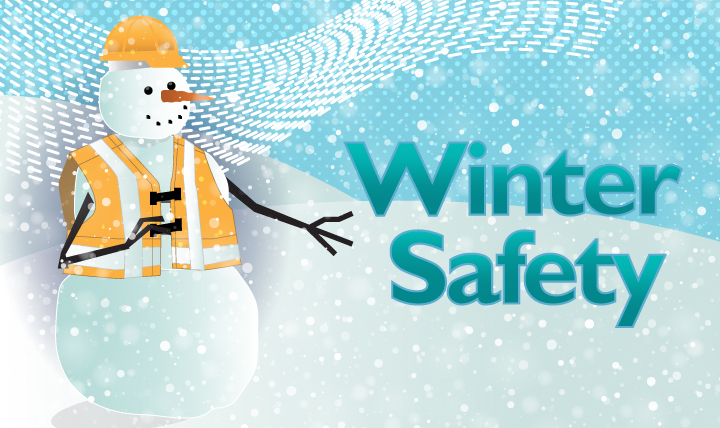|

What to Wear
Dress infants and children warmly for outdoor activities. Several thin layers will keep them dry and warm. Clothing for children should consist of thermal long johns, turtlenecks, one or two shirts, pants, sweater, coat, warm socks, boots, gloves or mittens, and a hat.
- The rule of thumb for older babies and young children is to dress them in one more layer of clothing than an adult would wear in the same conditions.
- Blankets, quilts, pillows, sheepskins and other loose bedding may contribute to Sudden Infant Death Syndrome (SIDS) and should be kept out of an infant's sleeping environment. Sleep clothing like one-piece sleepers is preferred.
- If a blanket must be used to keep a sleeping infant warm, it should be tucked in around the crib mattress, reaching only as far as your baby's chest, so the infant's face is less likely to become covered by bedding.
Hypothermia
- Hypothermia develops when a child's temperature falls below normal due to exposure to cold. It often happens when a youngster is playing outdoors in extremely cold weather without wearing proper clothing.
- As hypothermia sets in, the child may shiver and become lethargic and clumsy. His speech may become slurred and his body temperature will decline.
- If you suspect your child is hypothermic, call 911 at once. Until help arrives, take the child indoors, remove any wet clothing, and wrap him in blankets or warm clothes.
Frostbite
- Frostbite happens when the skin and outer tissues become frozen. This condition tends to happen on extremities like the fingers, toes, ears and nose. They may become pale, gray and blistered. At the same time, the child may complain that her skin burns or has become numb.
- If frostbite occurs, bring the child indoors and place the frostbitten parts of her body in warm (not hot) water. 104° Fahrenheit (about the temperature of most hot tubs) is recommended. Warm washcloths may be applied to frostbitten nose, ears and lips.
- Do not rub the frozen areas.
- After a few minutes, dry and cover him with clothing or blankets. Give him something warm to drink.
- If the numbness continues for more than a few minutes, call your doctor.
Winter Health
- If your child suffers from winter nosebleeds, try using a cold air humidifier in the child's room at night. Saline nose drops may help keep tissues moist. If bleeding is severe or recurrent, consult your pediatrician.
- Many pediatricians feel that bathing two or three times a week is enough for an infant's first year. More frequent baths may dry out the skin, especially during the winter.
- Cold weather does not cause colds or flu. But the viruses that cause colds and flu tend to be more common in the winter, when children are in school and are in closer contact with each other. Frequent hand washing and teaching your child to sneeze or cough into the bend of her elbow may help reduce the risk of colds and flu.
- Children between the ages of 6 and 59 months should get the influenza vaccine to reduce their risk of catching the flu.
Winter Sports and Activities
Set reasonable time limits on outdoor play to prevent frostbite. Have children come inside periodically to warm up.
Ice Skating
- Allow children to skate only on approved surfaces. Check for signs posted by local police or recreation departments, or call your local police department to find out which areas have been approved.
- Advise your child to: skate in the same direction as the crowd; avoid darting across the ice; never skate alone; not chew gum or eat candy while skating.
- Consider having your child wear a helmet while ice skating.
Sledding
- Keep sledders away from motor vehicles.
- Children should be supervised while sledding.
- Keep young children separated from older children.
- Sledding feet first or sitting up, instead of lying down head-first, may prevent head injuries.
- Consider having your child wear a helmet while sledding.
- Use steerable sleds, not snow disks or inner tubes.
- Sleds should be structurally sound and free of sharp edges and splinters, and the steering mechanism should be well lubricated.
- Sled slopes should be free of obstructions like trees or fences, be covered in snow not ice, not be too steep (slope of less than 30º), and end with a flat runoff.
- Avoid sledding in crowded areas.
Snow Skiing and Snowboarding
- Children should be taught to ski or snowboard by a qualified instructor in a program designed for children.
- Never ski or snowboard alone.
- Young children should always be supervised by an adult. Older children's need for adult supervision depends on their maturity and skill. If older children are not with an adult, they should always at least be accompanied by a friend.
- The AAP recommends that children under age 7 not snowboard.
- Consider wearing a helmet.
- Equipment should fit the child. Skiers should wear safety bindings that are adjusted at least every year. Snowboarders should wear gloves with built-in wrist guards.
- Slopes should fit the ability and experience of the skier or snowboarder. Avoid crowded slopes.
- Avoid skiing in areas with trees and other obstacles.
Sun Protection
- The sun's rays can still cause sunburn in the winter, especially when they reflect off snow. Make sure to cover your child's exposed skin with sunscreen.
Snowmobiling
- The AAP recommends that children under age 16 not operate snowmobiles and that children under age 6 never ride on snowmobiles.
- Do not use a snowmobile to pull a sled or skiers.
- Wear goggles and a safety helmet approved for use on motorized vehicles like motorcycles.
- Travel at safe speeds.
- Never use alcohol or other drugs before or during snowmobiling.
- Never snowmobile alone or at night.
- Stay on marked trails, away from roads, water, railroads and pedestrians.
|

